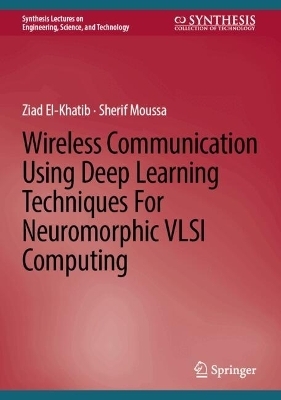
Wireless Communication Using Deep Learning Techniques For Neuromorphic VLSI Computing
Springer International Publishing (Verlag)
978-3-031-73799-2 (ISBN)
- Noch nicht erschienen - erscheint am 27.11.2024
- Versandkostenfrei
- Auch auf Rechnung
- Artikel merken
This book describes Deep Learning-based architecture design for intelligent wireless communication systems and specifically for Deep Learning-based receiver design. Deep Learning-based architecture design utilizes Deep Learning (DL) techniques to reformulate the traditional block-based wireless communication architecture. Deep Learning-based algorithm design utilizes Deep Learning methods to speed up the processing at a guaranteed high accuracy performance. Automatic signal modulation classification in AI-based wireless communication can be done using deep learning techniques to improve dynamic spectrum allocation. Automatic signal modulation recognition in wireless communication is described using Deep Learning techniques to improve resource shortage and spectrum utilization efficiency. Moreover, using deep learning neural network circuit methods and doing parallel computations on hardware can reduce costs. Spiking neural network (SNN) provides a promising solution for low-power hardware for neuromorphic computing. Spiking Neural Networks circuit functions with a pre-trained network's weights consume less power. Spiking neural network is more promising than other neural networks that can pave a new way for low-power computing applications. Analog VLSI is utilized to design spiking neural networks circuits such as silicon synapse and CMOS neuron.
Dr. Ziad El-Khatib PhD in Electrical and Computer Engineering from Carleton University Canada. Assistant professor at Canadian University Dubai. Dr. Ziad El-khatib received his M.A.Sc. from Carleton University Canada and his B.A.Sc. in Electrical Engineering from University of Ottawa Canada. He has several years of industry design experience in the field of communication integrated circuits and semiconductors at various companies including Nortel Networks, Harris Corporation, Corel Corporation, Chrysalis-ITS Semiconductor and Itron Inc. USA where he was also an adjunct professor. He was assistant professor in the faculty of Electrical and Computer Engineering at Rochester Institute of Technology Dubai. He is currently assistant professor in the faculty of Electrical and Computer Engineering at Canadian University Dubai. His research interests include silicon based integrated circuits for radio frequency communications and deep learning AI-based radio systems for wireless AI communications. He has a book published through Springer on radio frequency amplification and linearization techniques and numerous IEEE journal and conference papers.
Dr. Sherif Moussa PhD in Electrical and Computer Engineering from University of Quebec Trois-Riviers, Canada. Associate professor at Canadian University Dubai. Dr. Sherif Moussa received his PhD in Electrical and Computer Engineering from University of Quebec Trois-Riviers, Canada, and his MSc degree in Electrical and Computer Engineering form University of Waterloo, Canada. His research areas are wireless communication, computer networks, and VLSI design. His research specifically focuses on MIMO-OFDM algorithms, multiple access OFDM, FPGA design and optimization. Dr. Moussa joined CUD in 2007 where he currently is working as an Associate Professor at School of Engineering. Prior to joining CUD, he was a lecturer at School of Engineering, Centennial College, Toronto, Canada. Dr. Moussa is currently an active researcher who published in many international journals and conferences related to his field and he also currently serve as a reviewer and technical committee member for many international conferences.
Introduction.- Deep Learning Techniques for Wireless Communication Systems.- Radio Modulation Classification Optimization Using Combinatorial Deep Learning Technique.- Modulation Classification Performance Simulation Results.- Spiking Neural Networks Neuromorphic Computational System.- A Silicon Synapse with an Adaptive CMOS Neuron For Neuromorphic Computing.- Adaptive Quadratic Integrate-and-Fire CMOS Neuron Performance.- Conclusion.
| Erscheint lt. Verlag | 27.11.2024 |
|---|---|
| Reihe/Serie | Synthesis Lectures on Engineering, Science, and Technology |
| Zusatzinfo | Approx. 150 p. 50 illus. in color. |
| Verlagsort | Cham |
| Sprache | englisch |
| Maße | 168 x 240 mm |
| Themenwelt | Mathematik / Informatik ► Informatik |
| Technik ► Elektrotechnik / Energietechnik | |
| Schlagworte | Deep learning techniques • Higher Order Cumulant • long short term memory • Signal to Noise Ratio • Wireless Communication Systems |
| ISBN-10 | 3-031-73799-7 / 3031737997 |
| ISBN-13 | 978-3-031-73799-2 / 9783031737992 |
| Zustand | Neuware |
| Haben Sie eine Frage zum Produkt? |
aus dem Bereich


